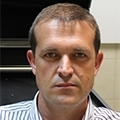Open Challenges of On-Machine and In-Process Metrology for Precision Manufacturing
A special issue of Metrology (ISSN 2673-8244).
Deadline for manuscript submissions: closed (15 September 2023) | Viewed by 2412
Special Issue Editors
Interests: manufacturing metrology; precision machine design; dynamics and vibrations; materials characterization; actuators
Interests: modelling, measurement and compensation of machining errors; error separation techniques; uncertainty analysis; signal processing and fault diagnosis
Interests: surface metrology; dimensional metrology; on-machine metrology for advanced manufacturing systems
Interests: dimensional metrology; machine vision metrology; portable metrology; robot metrology; gear metrology; surface inspection; numerical uncertainty analysis; numerical models for kinematic parameters identification; additive manufacturing; artificial intelligence and machine learning
Special Issue Information
Dear Colleagues,
This Special Issue will cover the current and most-pressing open challenges in the application of on-machine and in-process metrology for precision manufacturing.
Submissions are particularly welcomed in the following subject areas:
1. Measurement for applications in process monitoring and control
- Innovative measuring technologies for on-machine and in-process metrology of fundamental quantities;
- On-Machine and in-process measurement for monitoring components of manufacturing systems or entire manufacturing machines (e.g. rotary spindle metrology, linear axis metrology, etc.);
- On-Machine and in-process measurement of roundness/cylindricity/straightness/flatness;
- On-Machine and in-process measurement of surface topography;
- On-Machine and in-process measurement at micrometric and sub-micrometric scales.
2. Measurement uncertainty estimation and calibration
- Estimation of measurement uncertainty and assessment of measurement error sources for on-machine and in-process measurement;
- Calibration and self-calibration of measuring systems for on-machine and in-process metrology.
3. Data processing
- Novel computational solutions for fast and lightweight measurement data processing, for application in on-machine and in-process metrology;
- AI and machine learning for on-machine and in-process metrology: novel frontiers in data processing, data interpretation, uncertainty estimation and calibration;
- Digital twins to support on-machine and in-process metrology.
Dr. Sudhanshu Nahata
Dr. Shengyu Shi
Prof. Dr. Nicola Senin
Prof. Dr. Jorge Santolaria Mazo
Guest Editors
Manuscript Submission Information
Manuscripts should be submitted online at www.mdpi.com by registering and logging in to this website. Once you are registered, click here to go to the submission form. Manuscripts can be submitted until the deadline. All submissions that pass pre-check are peer-reviewed. Accepted papers will be published continuously in the journal (as soon as accepted) and will be listed together on the special issue website. Research articles, review articles as well as short communications are invited. For planned papers, a title and short abstract (about 100 words) can be sent to the Editorial Office for announcement on this website.
Submitted manuscripts should not have been published previously, nor be under consideration for publication elsewhere (except conference proceedings papers). All manuscripts are thoroughly refereed through a single-blind peer-review process. A guide for authors and other relevant information for submission of manuscripts is available on the Instructions for Authors page. Metrology is an international peer-reviewed open access quarterly journal published by MDPI.
Please visit the Instructions for Authors page before submitting a manuscript. The Article Processing Charge (APC) for publication in this open access journal is 1000 CHF (Swiss Francs). Submitted papers should be well formatted and use good English. Authors may use MDPI's English editing service prior to publication or during author revisions.
Keywords
- machine tool metrology
- dimensional metrology
- spindle metrology
- error separation techniques
- novel measurement approaches
- micro- and nano-manufacturing
- computational metrology
- uncertainty analysis
- surface metrology






